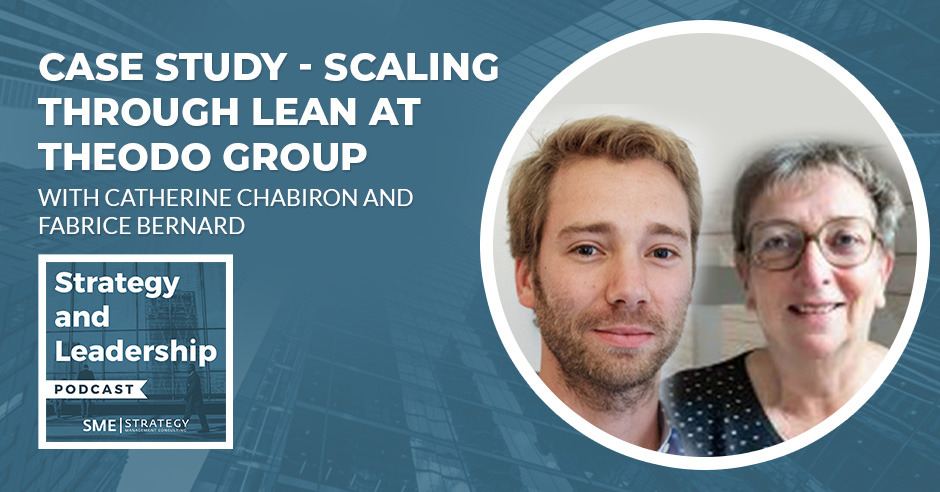
Fast-growing companies tend to develop Big Company Disease, where growth dramatically slows down. Business owners find their ultimate challenge in scaling up their business. But fear not, because in this episode, Fabrice Bernard, CTO and co-founder of Theodo Group, and Catherine Chabiron, the author of Learning to Scale at Theodo Group: Growing a Fast and Resilient Company, talk about how successful business owners are scaling through lean. Catherine, a Lean Sensei, explains how teams can adopt Lean as their organizational methodology. Meanwhile, Fabrice shares the lessons he learned from his own Lean journey. To wrap up the conversation, Catherine and Fabrice leave some valuable advice for business owners when embracing Lean. Don't miss out on today's episode—join us now!
Listen on Spotify: https://open.spotify.com/episode/2yEIjAUYNWb9Aa7M1wrteG?si=2c4cfcc03dcb4d66
Listen on Apple Podcasts: https://podcasts.apple.com/ca/podcast/case-study-scaling-through-lean-at-theodo-group/id1202449526?i=1000635439320
---
Watch the episode here
Listen to the podcast here
Case Study - Scaling Through Lean At Theodo Group
With Catherine Chabiron And Fabrice Bernard
My guests are Catherine Chabiron and Fabrice Bernard. Fabrice is the Cofounder and CTO at Theodo Group, and Catherine is the author of Learning to Scale at Theodo Group: Growing a Fast and Resilient Company. I wanted to have these folks on to share their learnings, experience, and case studies in terms of what Lean can do in the non-traditional sector. Catherine and Fabrice, I'm excited to have you. Why don't you tell our readers a little bit about yourselves and we will go from there? Catherine, why don't you start us off?
A very quick background on my side. I'm not in the digital business. I was in the automotive business and this is where I learned about Lean and I studied about Lean extensively. This is where I went to Japan and tried to understand. Lean comes from Toyota. We started looking at what Toyota was doing and they were doing something very different from the traditional industries. They were very successful at it. We started looking at it in the automotive business. Otherwise, we would have been out of the market. This is my background now. I was studying Lean in automobile and then started moving to other areas like other industries or services and eventually digital, and this is where I met Theodo.
I'm Fabrice. I'm the Cofounder and CTO of Theodo. We are an international tech consultancy. We have been helping our clients for many years. Design, build, and deploy tech solutions. Mostly digital web-based technologies, mobile apps, or machine learning algorithms. The reason we are here is because we had a key movement in our history back in 2012 where we got agile.
We got it and it helped us scale so well because all of a sudden, we had this right way of working. The teams were empowered with the customer or our clients. Immediately, we started thinking, “If there are frameworks out there that can completely transform our business.” Like Agile and Scrum had helped us transform the projects and how we deliver projects, there must be similar frameworks to transform how we grow the business.
We were quite optimistic about that. We realized that the solution was not out there that easily. We had to look for it for quite a long time, but we finally met someone who told us, “I was in a similar situation to yours. I discovered Agile. I found it completely a game changer, but I also realized in a larger organization, it was not enough. That's when I discovered Lean. If you want it, I’d like to lead you a bit on how to start your Lean journey.” That's how we started then. It was back in 2013.
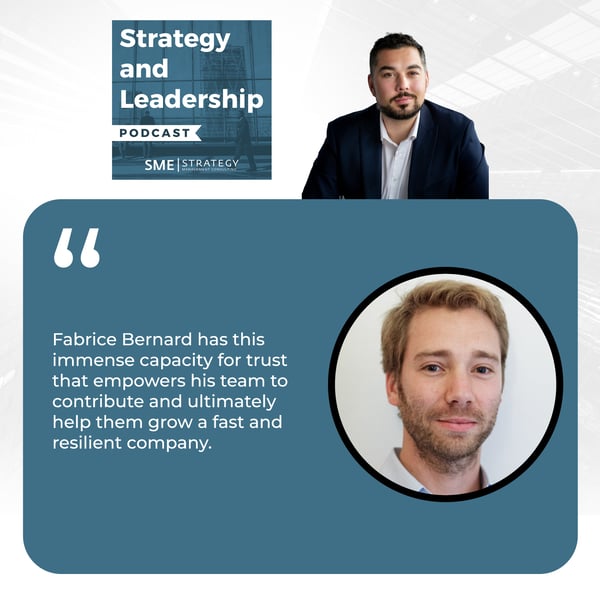
There are lots to unpack there. One of the things that Catherine said being in automotive, we could not do Lean as in that was the standard. Depending on your industry, software you have Kanban or Agile. For a lot of things, it's standard. It's so interesting when you talk to and I talk to across all industries doing strategic planning.
You have folks in manufacturing but not sophisticated manufacturing. They are non-profits and growing their systems and recognizing that there are the stuff that you take for granted or do normally and operationalize and there are the things that you take strategically to work on the business, and it sounded like the agile and Lean strategically had a big impact.
The two of you coming together is interesting. What were some of the 2 or 3 big learnings from that 10-year journey? What was surprising? What did you not expect or what were some of the things that you were pleasantly surprised to discover as you went on implementing this process and whoever wants to tackle that question first?
To give you a few spontaneous answers and Catherine can then add her point of view she has from being an outsider and observing us. The first problem is Lean is such a paradigm change that there are so many things that change in the way we look at things. I'm going to try to find the top three. The first one.
The first big Lean change that we had was empowering the teams contribution right in its tracks on value for the customer. Very good treaty for us. It meant that we had this. It's a funny anecdote and in hindsight, now I'm like, “I can't believe we did that.” At the time, we would collect the client satisfaction every week, but only the company directors would collect it and look at it, which was so weird.
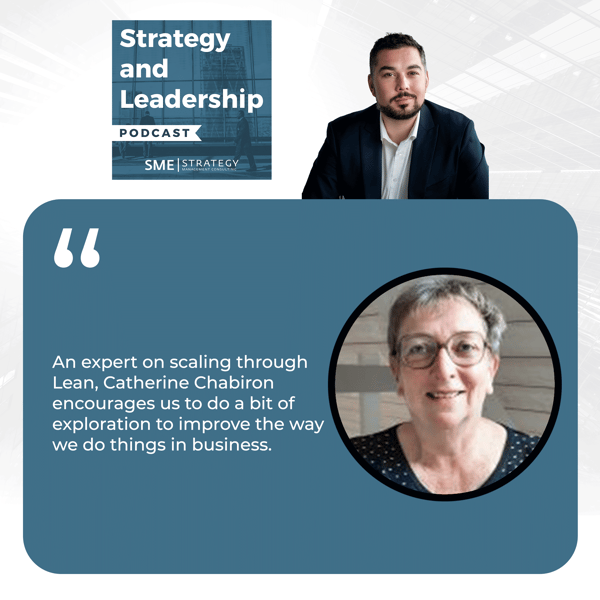
It meant that despite being agile, despite having the customer in the middle of the team, we would ask the customer what they thought and then keep it for ourselves in our little post office. One big challenge was saying, “This is something the team should know about. This is a great indicator for them whether they are doing a good job or not because they have direct feedback.”
We asked the client to give us a rank of a grade from 0 to 10, and then we said, “If it's eight or below eight, then that's not good enough. We need to analyze it. The first thing was like, “We can empower the team to look at the value, the reality, and then we can teach them problem-solving so they can do an amazing job at analyzing and reacting to it.
The first big change. We already have two in there. Another big learning is looking at individual growth. You are not looking to improve your company as a set of processes that you need to work on and that you need to enforce. You are completely changing your mindset. You are thinking, “To deliver great products, I need to have great thinking from the people.” How do I develop great thinking? One person at a time.
Then maybe the third one, I suppose it's spontaneous, but it's this idea that you are seeing all these problems and before Lean, you see them as they are these tough things that you need to tackle that are part of the business. They are difficult, but at the end of the day, you are happy because you are making business, and all of a sudden with Lean, you are seeing all the problems as opportunities for learning opportunities for individuals to develop their thinking.
Therefore with Lean, you try to create more problems, but at the beginning, you try to solve them. When you start solving them, you are like, “I don't have enough problems. It's probably because I'm not putting enough sensors in my organization to detect more problems,” and then so you start putting smaller sensors in more places, and therefore this incredible change that you have when you are on the Lean journey, which is all of a sudden you want more problems because you see them as these like system of TDG create for learning embedded than your production system.
With Lean, you try to create more problems, but at the beginning, you try to solve them.
There's a lot to unpack there. Catherine, I'm going to ask for our reader. I want to cut back on what Fabrice said first. There was so much in there. One is the idea of capturing data quickly and quickly, some people do a net promoter score once a year and even then, they are like, “That's a lot of work.” You are doing it once a week so that you can get people to be able to do that iterative change. Focusing on individual growth from a skills standpoint, but also an empowerment standpoint, like allowing people to understand the problem, solve the problem, or remove communication silos so that you can then support the people.
Accomplishing that, and then the whole mental shift of saying, “Problems are opportunities and it's not bad.” In our North American culture, I find that people want to avoid conflict and look bad because it means that they are bad. Here, you look at it and say, “This is an opportunity for all of us to change.” Before, Catherine, I go to you for those of you who don't know Lean, I'm going to say, “Get Catherine's book because it will explain to me both the fundamentals and the advanced pieces. Catherine, what were some takeaways from you, and if anything, you want to allude from the book as well?
The thing I can add to what Fabrice said, which is very comprehensive on the major changes is that Lean before the foremost customer obsession. We need to adjust permanently to the customer's needs and the customer's value to make sure that the customer will return. There is a very strong customer focus. You do know as well as I do because we all have experiences in our daily lives about poor customer service or relationships and so on.
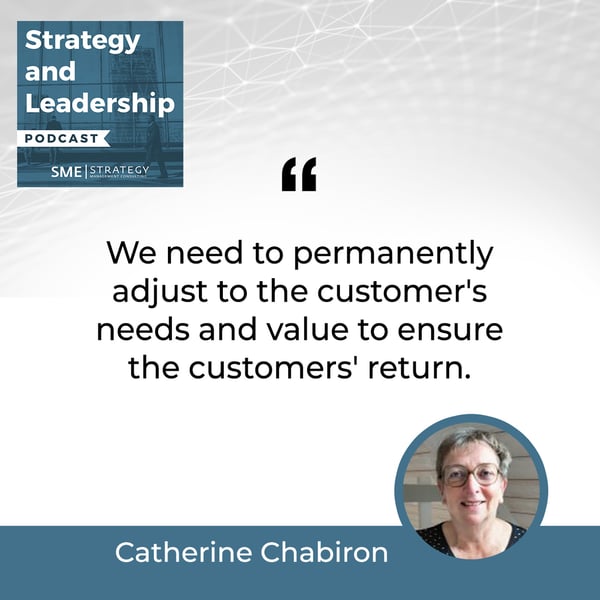
Particularly in France, maybe less so in the US or Canada. Those poor services generally stem from the fact that the people who are in customer service positions do not have the tools, systems, or information. They are not backed up, they are not helped or they are not even empowered to answer our questions.
The whole point of Lean is to give a framework. I remember what your cofounder, Fabrice Bernard, would say. “The framework of Lean gives me the permanent refocus of the customer. The capacity to engage people by giving them proper tools, systems, and enablers of all kinds and developing, and what Fabrice said is extremely important.
It's very tough to create personal or individual progression so that everybody will be more confident or challenged. It's fine to have challenges. It can be fun at work to have a challenge, but if you don't have the proper competence, it's horrible. The challenge goes with competence. You cannot strive and survive in a challenge without developing competence, and that's what they are trying to do. How do they develop competence to engage people in exploration, not simply execution?
Interesting balance that you touched on there. The balance between potency and resources is that if you have all of the competence in the world but are not given the backend support to accomplish it, you don't give permission to implement a change. You are not given the technology to implement change, you are not given the people resources to implement change, then it's all for naught.
That's where I have seen teams fail is that they say, “We are all in on this thing, but you have to do it on a shoestring budget. You have to make it work.” That's not impossible, it's just, which is it? They are two opposite roads. One is fully bought into this Lean customer-focused thing, and the other is conserve.
A shoestring budget can be a challenge in itself, and this is how Tota started, by the way. One of the reasons they studied the flexibility of the resources is because they had a shoestring budget. They had to be more clever than the others to build on their existing resources.
Can we talk about that a little bit? One of the things that our readers might experience when they hear this and say, “This thing is this huge.” Even the word Lean is scary in its terminology. The commitment to it is you have to be bought in. You have to have 100% commitment. If anybody's watched the show The Bear, which is a North American TV show about cooking, they say focus on the customer experience and everything is measured to the second, which I find interesting in this conversation, but I don't think people would have picked up that context in a restaurant.
Let's say you want to have this focus on the customer, you want to improve your systems, and you want to do all of that, but you are limited on resources like all organizations are. Catherine, where are some easy starting points for teams that want to embrace Lean as a part of their organizational methodology?
The first thing in the change of paradigm with Lean is that you are not going to rely on a few bosses to drive innovation and change. You are going to rely on everybody's creativity everywhere. Even with scarce resources, it's better to have the idea of ten frontline people than just one boss who is sitting away in another office. That's the first point.
How do you embrace it? You do small experiments. First, you need to be willing. You try it in a small team and start experimenting and changing or looking at the customer. Before that, make sure that the trust is there in that team. Make sure the tools work. Make sure they understand where we are going. They have a sense of purpose. Make sure the bosses are there to help because if you don't have those bases for trust, it won't bloom. If you want to try Lean experiments, try it in a team that has good support, trust each other and they are willing to endure the challenge and explore.
Fabrice, what about you coming from the chef side of things, you had to put a lot of trust into your team and I didn't ask how big you were at the time, but it can be hard to give up control. It can be hard to empower those people even though intellectually we want to. It's putting it in their hands and saying, I trust you to make the right decision at scale. What was that like for you as a cofounder or a CTO? What did you learn?
First, I have seen different sizes because of my Lean journey. When my Lean journey started, we were doing $1 million in revenue. Now we do $90 million in revenue. I have seen different sizes, and the interesting thing is it doesn't cost a lot at the beginning to start the journey. It's this very cheap way to start creating more value and more profit because this Lean idea is there's waste everywhere.
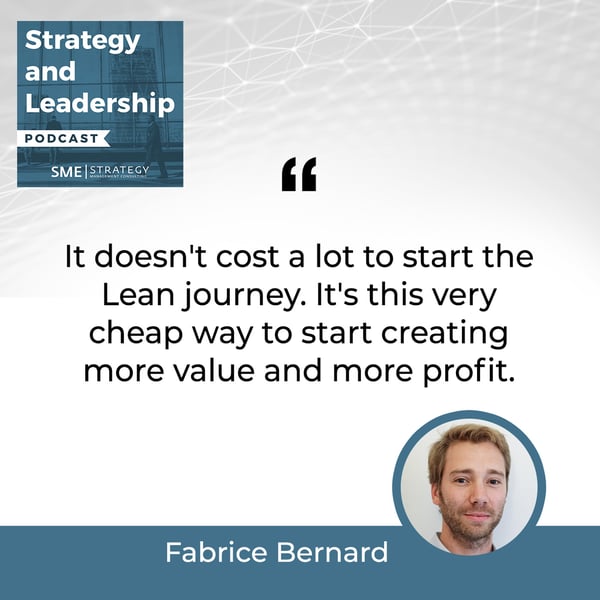
Especially at the beginning, the low-hanging fruit is that there is probably a lot of waste that your team knows about but is not nudged and empowered to address, and then the question is, how do you give up control on addressing that waste? You start small, so the risk is small, so you don't have to be scared about it. Very concretely speaking, because this is a bit conceptual, what you do is you go on the Gemba.
As a boss, you go look at the team. You observe the way they work and you start asking questions. By asking these questions with your experience and understanding of the value, if you are the boss of the business, you probably have a good holistic understanding of what the customers want. You ask questions and then through this dialogue, you identify some waste and you could potentially coach the team on problem-solving them.
That's how you start small and train the people so they start having confidence to do things. It's a good point you are saying on the purely trusting because there is a moment where you need to start giving up control and trusting the team. There's a way to do it, which is where you keep this control. The idea is not to go full on, “I give up on my responsibility as the director of the company.” It's those senses. You try to put in place the senses, the true problems, and because you create this culture where it's okay to look at a problem, you trust that problems will be made visible.
You trust that the people will try to problem-solve them and you have to create a culture where they pull the Andon code if they have not been able to problem-solve it. In our case, we call Andon, basically taking the phone and call the boss. At Toyota, the romantic view of the Andon is it's a code that the people on the production line can pull to stop the production line. In the service business, it's you take your phone, you call the boss and you are like, “I need to Andon you. There's something I don't know what to do with.” If you have this culture of people calling you when they have a problem and trust you to not react the wrong way, you can start giving up control.
I was going to confirm that there's a question of trust both ways, but the people will get engaged if they trust their bosses to come and help and the bosses will let go because they trust the people to look at the value.
That was what I was going to touch on as well. When I first heard it, I said, “It's a trust from the top down, but for it to move, it has to be a trust from the bottom up that they will be safe to report problems or opportunities, that they will be safe to call something when it stops.” I have seen low-trust organizations where they bring up problems. They say, “No, that's not a problem.”
It's like, “I don't believe what you are telling me and therefore, I'm not going to act on it.” That's how you stop any contribution right in its tracks. Thank you for pointing that out, Catherine. It's super important. Fabrice, your capacity to trust is one of the big things that has not only increased your top line but I'm sure your bottom line as well. That's very exciting.
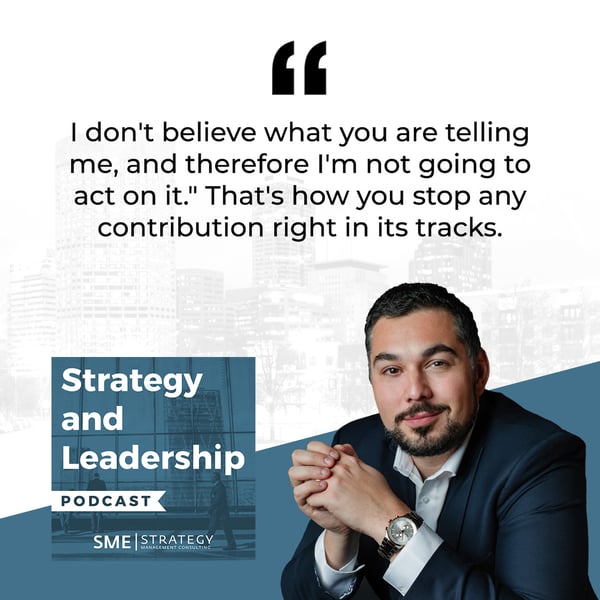
Time flies when we are having fun, folks. We are at the end of our time, but as we finish up, what is one piece of advice that you would want to give to our readers to take the next step on their Lean journey? I will take the first one and say go by Catherine's book available on Amazon. Catherine, why don't I start with you? What's one piece of advice you'd like to give our readers to be able to move forward on their journey?
Just try and do something about exploration. Try and improve a system that doesn't work a waste that's obvious that nobody has been looking at. Let me give you an example I have picked up from the book. One of the CTOs of the teams was visiting once, the tech in charge of the development of an app, and the guy had to test it on a number of mobile devices.
He didn't have the devices at hand. He had to go and look for them. He didn't know how they worked. He didn't know how to upload the test version. He lost minutes and the CTO was asking him, “Is it normal conditions? Would you like to try and have a go at it to try and improve the situation?” Not giving the solution but proposing to look and explore the situation.
The guy did so and he brought the problem from 17 to 10 minutes because he gave himself, allowed himself this time to explore other options, not live with the waste. It's very much a question of going to the Gemba for the bosses. Look at those abnormal conditions and nudge the people into exploring other ways.
Thank you, Catherine. For Fabrice, how about you? Number one tip for our readers in terms of how to move forward.
You have already mentioned the best. Reading books is how we started. Showing curiosity on the ground, observing your teams, looking at problems, and being super curious about the problem, but that's already been mentioned by Catherine. The next step after that or we have already done a lot.
I will give you a different one. From a leadership perspective, if you focus on being a leader, what would you recommend to the CEOs, CTOs, cofounders, and founders out there in terms of them moving forward with this or, in general, a good leadership principle?
I stick to my point and go to the Gemba because I'd say the third thing. One thing I like more about the leadership team. Something that would like to interest leaders is in Lean, there's a lot about developing thinking. Good thinking will bring good products. If you want to lead by example on good thinking, what is super interesting, it's changing from a meeting culture to a leadership team. We meet, we talk, and we have PowerPoints. As a leadership team, we think hard about our problems and the changes we want to implement.
Good thinking will bring good products. If you want to lead by example in good thinking, it's changing from a meeting culture to a leadership team.
What is very interesting is you have got two amazing examples of this. You have got Toyota, who have what they call the A3 culture. They will document a change they want to bring to the team or an organization and document it. There's different steps of thinking so that you can understand the rationale and anyone in the leadership team can understand deeply the reasoning of the person who wants to implement the change.
You have another example, very similar, which is Amazon. Amazon has changed it slightly to their culture because they started as a bookseller, so they call it a six-pager memo, but it’s the same ID saying, “I’m fed up with PowerPoint. The thinking behind the PowerPoint is too shallow. We are going to take the time to write six pages of good-quality text to explain what we want to do and why we want to do it.” That's great leading by example so we can think harder as a leadership team, and that also shows the teams on the ground. They are documenting their thinking. They share them with us. When we have a problem, we can also think harder about it.
I appreciate you both. One of the things, so A3 is if you don't know about it, everything that you need to know about a problem should be able to be written on an A3 piece of paper. The six-page memo is you need to be able to write the six-page memo, as Fabrice mentioned. You don't expect people to read it ahead of the meeting. You start the fifteen minutes ahead of the meeting reading the memo so that everybody is explicitly on the same page there. A quick one, Catherine, because we got to go.
Fabrice mentioned it. How the changes we plan will impact the others. It's one of the big company diseases and working in silo. This discussion about the changes is so important.
There's a lot that goes into it. One of the things that I encourage you as readers to think about is raising your standards. It's what you accept as waste, what you think is what you want to accomplish, and then be able to have that commitment. The other thing that we didn't talk about is a relationship with an outside partner.
Fabrice and Catherine were partners and if I understand, Catherine is a consultant. Being able to bring specialists into your team to support you on that journey, not only because they have a deep expertise in it, which Catherine does, as you will learn from her book and her bio. Also, to have somebody who can provide an external view of what you are doing.
It's extremely valuable so that they can test your assumptions on things, whether you will have a partner to sanity check. Catherine and Fabrice, thank you so much. It's been such a pleasure. I appreciate you being generous with your time and later in the day when you are in Paris and it's a real pleasure chatting with you. Thank you both.
Thank you
---
My guest Catherine Chabiron, who is the author of Learning to Scale at Theodo Group, and Fabrice Bernard, who is the Cofounder and CTO at Theodo Group. I hope you learned something about the opportunity to embrace Lean inside your organization to minimize ways to create a truly transformational culture in your organization by taking little problems and turning them into great opportunities. Thanks again for reading. Thanks for being here. Thanks for subscribing. Be sure to share this with somebody you like. You can even share it with somebody you don't like, but that said, I appreciate you being here. Thanks for reading and I will see you next time.
Important Links
About Fabrice Bernard
 Fabrice Bernhard is CTO & Co-Founder of Theodo Group. He co-founded Theodo in Paris in 2009, which has grown on average 50% a year for the last 8 years and generated 90M€ turnover in 2022. He is now based in London to help on the international expansion.
Fabrice Bernhard is CTO & Co-Founder of Theodo Group. He co-founded Theodo in Paris in 2009, which has grown on average 50% a year for the last 8 years and generated 90M€ turnover in 2022. He is now based in London to help on the international expansion.
About About Catherine Chabiron

Catherine Chabiron is an established expert in Lean management with a professional journey spanning over 40 years. She has accumulated valuable experience in a range of service and support functions, including IT, Logistics, Sales, Finance, and HR, both in France and globally.


